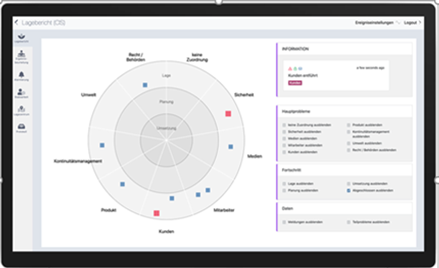In the future, the flood of digital data can no longer be managed with pencil and paper – A digital world also needs digital Crisis Management – The ever-increasing flood of information must be controlled and processed on a systematic basis.
Our society and technology have changed enormously over the past two decades. New technologies and digitization are encroaching on all areas of our society and economy. This change also accompanies modern Crisis management. But what will Crisis Management look like in the future and what challenges will the future Crisis Manager face? The experts at Verismo have been dealing with this topic for years, regularly discuss it with practitioners and have taken a look into the future.
Article by Roger Huber
“The future of Crisis Management is digital, but that won’t surprise anyone,” explains Dr. Klaus Bockslaff, one of the two managing directors of Zurich-based IB Götsch AG, provider of DEMiOS 3, which is probably the most advanced Crisis Management software on the market today. In order to be perfectly positioned for future challenges, the consulting company Verismo GmbH from Küsnacht therefore joined forces with the IT company IB Götsch AG in 2018. There are good reasons for this.
In order to be able to assess the challenges of the future in Crisis Management, it is first necessary to make an assessment of the current situation. For example, what will the changes brought about by the spread of digital technology look like? Connectivity is the most powerful megatrend of our time. The principle of networking dominates social change and opens a new chapter in the evolution of society. Digital communication technologies are fundamentally changing our lives, reprogramming our society and giving rise to new lifestyles and behavior patterns.

Dr. Klaus Bockslaff

Tools of the future? Virtual Reality solutions
To successfully accompany this fundamental upheaval, companies need new network competencies and a holistic, systemic understanding of digital transformation. But this also brings opportunities and risks that were unimaginable a generation ago and will strongly drive Crisis Management.
Merging is a strategic necessity
«Aus diesem Grund war auch der Zusammenschluss unserer beiden Unternehmen und Kernkompetenzen eine strategische Notwendigkeit», erklärt Partner Dr. Mathias Götsch im Gespräch. Denn die digitale Komponente im Krisenmanagement werde immer wichtiger. «Weltweit nehmen die Angriffe auf Unternehmen und Institutionen in Form von Sabotage, Datendiebstahl oder Spionage dramatisch zu». Unternehmen weltweit rücken seit Jahren in den Fokus von Cyberkriminellen.

Dr. Mathias Götsch
Identity and data theft are particularly high on the list of computer crime followers. This trend has been exacerbated by the home office during the Corona crisis. “Hackers are becoming more capable as they execute targeted, methodical attacks that many companies are unable to combat consistently and quickly enough. In addition, many companies do not assign top priority to this threat,” explains Mathias Götsch. “Especially as corporate IT is increasingly being replaced by cloud-based systems, which results in new challenges.”
The situation assessment pays particular attention to the increasing use of mobile devices in both private and professional environments. Companies must adapt to new work and communication behavior, partly as a result of the COVID crisis, by offering their employees new technologies, such as collaboration software like MS Teams/Office365. It follows that information security continues to grow in importance.
In an exchange with experts from Germany, Austria and Switzerland, Peter Markovitz, Senior Consultant and Product Manager DEMiOS, presented the following observations from the environment of the past 12 months:
Developments:
- The Corona crisis has pushed digitization forward by 5 years
- Adoption of cloud services has increased because their security has increased and vulnerability has decreased
- The interconnectedness of solutions and their scalable availability permeates all sectors
- IT departments will need to expand their role as innovators and drivers of digital issues
- The most important and protectable assets in an enterprise are data
- Under “One Security”, enterprise security and the IT department will merge
New baseline requirements and replacement of tools:
“These developments bring us to an initial assessment,” explains Klaus Bockslaff. “In addition to the methodical approach to a crisis, the Crisis Management of the future must also have competencies in digital communication, digital Crisis Management, data protection, cyber security, and crisis communication via “old” media and social media; these are basic requirements of today and will most certainly be of tomorrow.”
According to Götsch, a future-proof Crisis Management application must enable a company to connect existing solutions such as alerting tools, event reporting systems, collaboration tools or programs such as Office365 with the Crisis Management application via interfaces and to integrate them cost-effectively into the existing IT system landscape.
In their presentations, Peter Markovitz and Klaus Bockslaff showed the participants of the regular Verismo webinars which potential techniques and possibilities they can expect in the future. A video from Microsoft even showed a possible virtual staff work that can be used in the future during crises. One of the clous, the use of virtual reality goggles. The discussion with the crisis managers from companies also showed that the Crisis Management and collaboration software already available on the market, such as Teams from Microsoft, will replace the existing alerting tools based on “old” methods.

Peter Markovitz
The dialogue with the Verismo founder also looks at the networking of the future. “Crises always open up two possibilities,” he explains. “Crises can lead to regression, i.e., a relapse into less complex systems, or lead to an integration of subsystems.” Here, the Bockslaff and Götsch team concludes, “Our future depends on the interactivity of our subsystems. The Corona crisis has led to new experiences at these interfaces that will change and improve our future.”
And what does that mean for Crisis Management?
Peter Markovitz explains: “Today, a modern Crisis Management application supports the crisis team in its work, i.e. it addresses these typical weak points of the classic Crisis Management process, structures orders and their controlling, simplifies logging and information transfer. It also helps to enable interaction between the members of one or more staffs and provide everyone with an overall picture of the situation in real time.”
He points out that the large amount of data that reaches the crisis team in a case today has to be managed and classified. “In a crisis team that still works on paper or with Excel lists, you are quickly overwhelmed and run the risk of losing the overview.” Bockslaff adds, “In the future, too, it will be important to react quickly, transparently and in a coordinated manner in critical times, in the event of a hacker attack, a search by the public prosecutor’s office, a major fire or blackmail, and not to forget anything.”

Crisis Information System
According to Verismo experts, digital Crisis Management will better optimize the course of a crisis in the future and, in the process, will accelerate the exchange of information that exists between the units involved in Crisis Management, such as the crisis team, situation center, crisis communication, emergency organization, action and service team or task force units. “In this way, leadership in extraordinary, time-critical situations can be efficient and Crisis Management can be proactive.” For Mathias Götsch, it is clear that further digitization brings great opportunities and challenges for companies. “Only those who know both sides, are familiar in dealing with the new environment, react to digital risks at an early stage and can deal with digital crisis communication and Crisis Management will secure their future viability in the long term as well.”

DEMiOS in the network of systems
Crisis Management reinvents itself again and again
Peter Markovitz adds: “Crisis Management has reinvented itself again and again. In the recent past, probably the most fundamental changes have taken place in terms of Crisis Communication and Crisis Management. This is because not only governmental and institutional due diligence obligations have been consolidated, but increasingly those of economic actors as well.”
No technical development has opened up such comparable possibilities for Crisis Management and Crisis Communication, he concludes. “On the one hand, new communication channels could be developed, and on the other hand, for the first time, area-wide and multidimensional strategic crisis coordination was ensured.” Added to this, he says, is the improved and increasingly developed digital infrastructure. “They facilitate Crisis Management and Crisis Communication immensely.”
At the end of the interview, Klaus Bockslaff returns to the core business of Crisis Management. “Our software supports our proven, field-tested and successful methodology. But in the future, too, it will be important to define clear processes and responsibilities in the run-up to a crisis.”
The DEMiOS 3 Crisis Management software also ensures that the processing of knowledge, before and during a crisis, is not lost, but can take effect. “A clear strategy right from the start, combined with comprehensible measures and their unambiguous communication, is the key to successful Crisis Management,” says Bockslaff.
